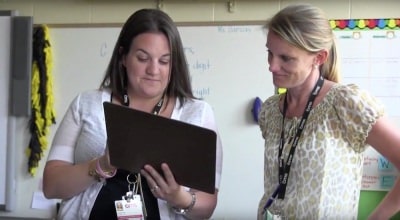

“One-size-fits-all doesn’t work,” says Mamie Hall, English teacher and dean of students at Research Triangle High School (RTHS), a three-year old charter school in the Research Triangle Park (RTP). “We enroll kids from so many different backgrounds, with such different skills, and we want to meet all their needs. ‘Flipping’ helped some, but it was still hard to hold the students accountable and let them move at their own best pace.”
RTHS opened in 2012 with the strong commitment to offering a rigorous college prep STEM education to a really broad spectrum of students. About 30 percent of our students enter the school each year working below grade level, and students come from 11 counties and over 60 middle schools. The school has used a blend of flipped videos and project-based learning to accelerate learning for all students. And yet, we found that our mission to “increase access” to a globally competitive education has been challenged by how to bring below-grade-level kids up to high school level quickly enough and successfully enough for them to indeed access our STEM curriculum.
A year ago, a visitor from the Charter School Growth Fund suggested RTHS take a look at Summit Public Schools in Northern California, and their Personalized Learning Program (PLP). I visited in spring 2014 to hear an overview of their PLP. I sat there with my mouth open, about 15 minutes into the presentation, realizing that I was hearing these guys describe what Eric Grunden, our principal, had envisioned when he wrote the education plan in our charter. Here was a school doing exactly what we had only dreamed about!
The core of all this innovation is an effort to teach all students — no matter their background — how to learn, how to think.
Personalized learning was the natural evolution of flipping and project-based learning for RTHS. Students were able to work through a complete ‘playlist’ of content material — flipped videos, textbooks, animations, and even games — learning to determine for themselves what material best helped them learn. Projects became the most significant part of their learning, where they applied the playlist content in seminars, presentations, proposals, and labs. The software that drove all of this enabled any educator supervising students at any time to know where that student was in their learning.
RTHS piloted this personalized learning method that same year.
The results
“We saw this transformational change to what we called ‘the Self Directed Learning Mindset’; that is, students realized that if they work, they can get it. They learned to believe in themselves,” said Lisa Austin, Common Core Math 1 teacher. At the same time, the school was able to move 13 percent of ninth graders into an AP Biology curriculum early in October, accelerating learning for students at the high end just as well. Teachers learned that with students who are ahead of the curve, the faculty really had to ‘up their game’ and make learning material more challenging to make students work to think, not to just find answers.
In other words, we were able to better teach all students — across the entire spectrum of learning backgrounds — how to learn.
RTHS has taken on a full ninith-grade implementation of Summit’s Personalized Learning Program this year. All ninth graders are taking their core courses using the PLP software. They work through core content, or “focus areas,” on their own, using extensive playlists created by our teachers or curated from Summit and elsewhere. Each focus area is short, a mini-module, with a 10-question quiz at the end. Additional and challenging focus areas allow students to reach for greater depth when they want it.
Arching across the content are projects, which are short or long endeavors that let students apply that learned content in writing, research, lab reports, presentations, or whatever the teacher invents. Projects are evaluated after completion on a cognitive skills rubric, which Summit worked with Stanford University’s SCALE program to develop. Projects are the place where students develop their 21st century college and career skills. For example, the cog skills rubric covers 36 domains of higher-order skills, including interpreting data, hypothesizing, active listening, and synthesizing multiple sources.
A fundamental part of the PLP program is to guide students to significant growth in these skills over their four high-school years. Every student has a weekly mentor, a teacher or staff member who coaches the student through looking at their long-term college goals, their weekly actions, and their evolving habits of success, helping the students to become self-directed learners with their eyes on the prize of college completion.
The core of all this innovation (the software, the rigorous content, the coaching) is an effort to teach all students — no matter their background — how to learn, how to think, and how to be the captains of their own ships for a future economy and learning world which hasn’t yet been invented.
Ninety-six percent of Summit’s graduates are accepted to college, and their school is ranked as the number one high school in the San Francisco Bay area. RTHS has our eyes on that prize too — for all the students who come to our school.




